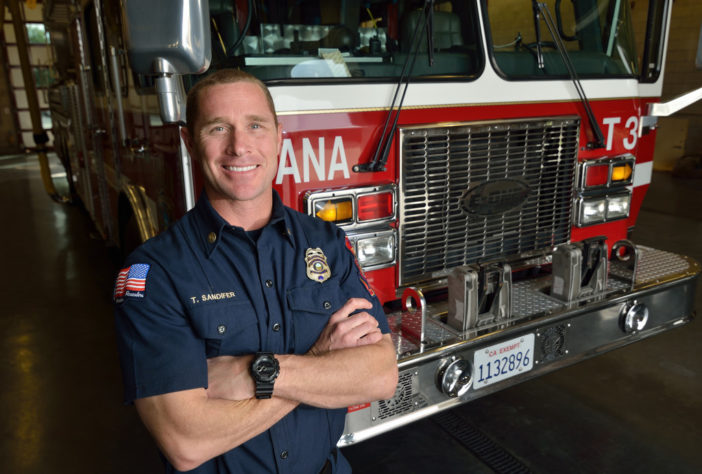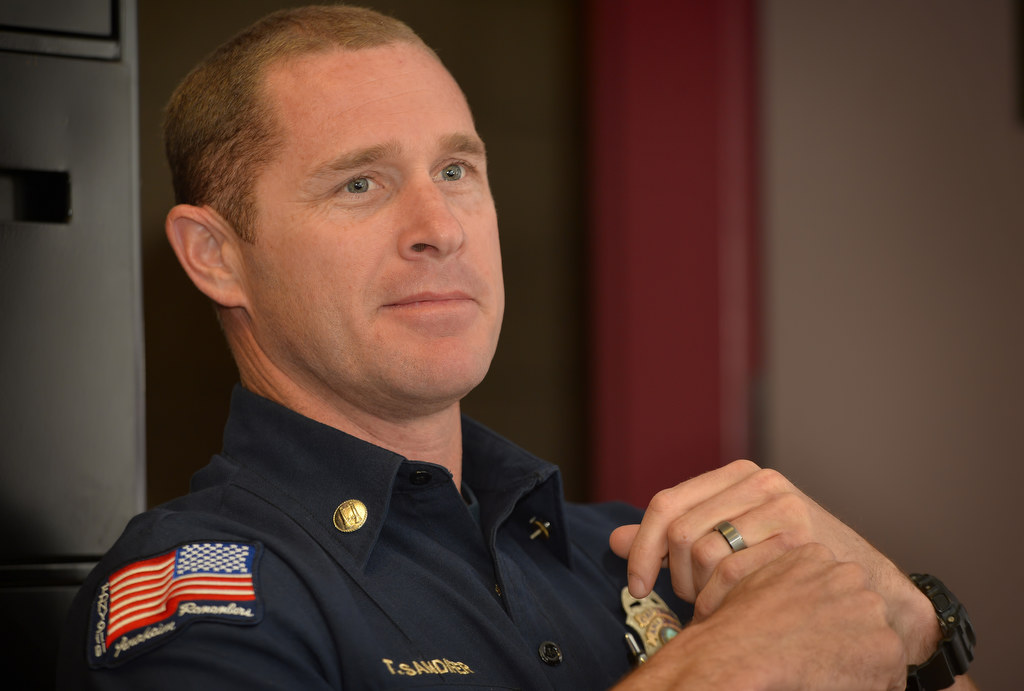It’s not about me.
Anaheim Fire & Rescue Capt. Tim Sandifer doesn’t use those exact words, but several times during a recent interview, he deflected credit for a big-time award he recently won.
Ed Bent, who died in March 2012, was a leader in establishing modern training and standards for California firefighters.
Bent spent 40 years as a firefighter, starting with the L.A. Fire Department in 1943.
By the time Bent retired in 1983, he had become synonymous with statewide policies and programs for new firefighters. He wrote training texts for, among other things, dealing with hazardous materials and building collapses.
Following his retirement in 1983, the California Fire Chiefs Association established the Ed Bent Training Excellence Award, given annually to top firefighting instructors in the state.

Capt. Tim Sandifer is a 15-year veteran of Anaheim Fire & Rescue. Photo by Steven Georges/Behind the Badge OC
Sandifer, 37, an Anaheim Fire & Rescue firefighter for 15 years, won the award for 2015 at a ceremony in Fresno in November.
But don’t expect him to gloat about it — much less willingly talk about it.
Don’t get him wrong.
Sandifer is grateful and proud to have received the Ed Bent award, but for him, it’s a reflection of Anaheim Fire & Rescue’s commitment to excellence as an agency — not some mega-achievement on his part.
“It’s probably more a reflection of the guys who helped me get to this point rather than a reflection of myself,” says Sandifer, who mentioned AF&R Battalion Chief Tim Adams among his mentors.
“Through his efforts, Tim Adams has pushed this entire agency and county, as well as the state, to higher standards of fire service training,” says Sandifer, who is part of AF&R’s training company.
Sandifer also credits AF&R Battalion Chief Chad Thompson and Deputy Chief Pat Russell with giving people like him a “huge leash” when it comes to training. “It’s not cheap to go out and do what we do,” Sandifer says. “They have been financially supportive but also morally supportive.”
A committee for the Ed Bent award selected Sandifer after reviewing several nomination applications, Adams said.
Sandifer trains firefighters locally and across the state in such modern tactics as transitional fire attack, positive pressure attack, and flow path.
These and other tactics are based on science and have been adopted into use following millions of dollars in research by institutions such as Underwriters Laboratory (UL), a global independent safety science company, and the National Institute of Standards and Technology.
“Tim was selected due to his dedication and commitment to the fire service, as well as his efforts and exceptional influence in connecting with firefighters while teaching modern fire behavior,” Adams says. “His teaching style has increased the knowledge, skills and abilities of thousands of firefighters across the state.”
Adams says Sandifer’s training not only has increased the safety of firefighters, but also has allowed them to provide better service to the communities they serve.
One of six captains assigned to Station 3, which is located in the Anaheim Resort area, Sandifer says he doesn’t know who nominated him for the Ed Bent award, but that the nomination came from outside Anaheim Fire & Rescue.
He says he was “absolutely” surprised to be nominated and even more surprised to win.
The award, Sandifer says, underscores Chief Randy Bruegman’s strategic plan to show leadership in the fire service industry, demonstrate excellence and pay it forward by training members of outside agencies.
“It’s cool that other (fire) departments allow us to go in there and trust our knowledge and our skills and preparation to go in and train their personnel,” Sandifer says.
He says he’s always been interested in training — perhaps a trait he inherited from his parents, who both were teachers. Sandifer’s father taught college math and his mother was an elementary school teacher.
In addition to training other firefighters, Sandifer, who grew up in Huntington Beach and is a former lifeguard for Newport Beach, teaches at the fire academy at Santa Ana College and is heavily involved in instructing new recruits to AF&R.
“When we do all this training,” Sandifer notes, “it makes us better at doing our jobs every time we get on that fire truck.”
 Behind the Badge
Behind the Badge





